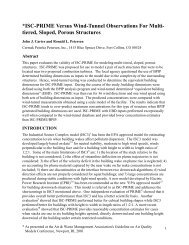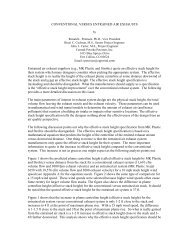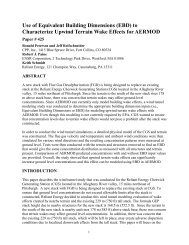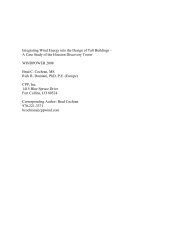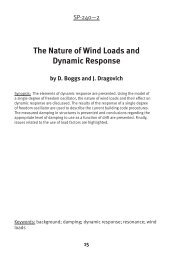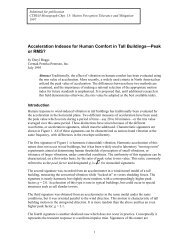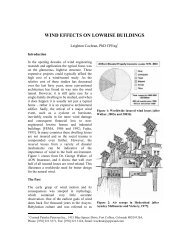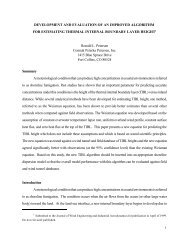Wind Load Analysis - CPP
Wind Load Analysis - CPP
Wind Load Analysis - CPP
Create successful ePaper yourself
Turn your PDF publications into a flip-book with our unique Google optimized e-Paper software.
<strong>Wind</strong> <strong>Load</strong> <strong>Analysis</strong><br />
of the roof. The calculator incorporates the potential increase<br />
in wind pressure in interior regions of the roof when a parapet<br />
wall is present, as well as the accelerated flow around rooftop<br />
objects such as HVAC units. The velocity pressure determined<br />
in the calculator is exactly as prescribed by ASCE 7-05, but the<br />
coefficients are based on actual wind tunnel data.<br />
USING THE DNV CALCULATOR<br />
The DNV <strong>Wind</strong> <strong>Load</strong> Calculator is posted on DNV’s website<br />
(see Resources) along with a user manual. The first step is to<br />
enter a series of inputs that are defined in ASCE 7-05: mean<br />
roof height, basic wind speed, directionality factor, importance<br />
factor, topographic factor, velocity pressure exposure<br />
coefficient and effective wind area. These inputs, which<br />
structural engineers are used to working with, are used to<br />
determine the velocity pressure according to ASCE 7-05 .<br />
A second set of inputs to the DNV <strong>Wind</strong> <strong>Load</strong> Calculator<br />
defines the PV array geometry. These parameters include<br />
effective wind area or tributary area, PV tilt, row spacing,<br />
height above the roof and the location of the array section<br />
being considered. Several factors are used to describe<br />
the array location, including the location within a subarray<br />
(north row, south row, eastern or western perimeter<br />
or interior), the roof location (corner, edge or middle) and<br />
the distances to nearby objects. The calculator also asks for<br />
the parapet height(s) on the building and the dimensions of<br />
rooftop objects that are taller than the array.<br />
For each mechanical subarray section—for example, a<br />
north row in the corner of the roof—the calculator provides<br />
a wind pressure in pounds per square foot (psf). This result<br />
is the estimated pressure that should be applied analytically<br />
in the upward and downward direction perpendicular to<br />
the PV module. The calculator also provides recommended<br />
offset distances from rooftop objects, such as HVAC units,<br />
which can create regions of accelerated flow around them.<br />
Comparison to results from ASCE 7-05. Comparing DNV<br />
<strong>Wind</strong> <strong>Load</strong> Calculator results to those determined using<br />
ASCE 7-05 is complicated because there is no one correct<br />
way to apply the standard to sloped PV modules on a flat<br />
roof. However, we have compared DNV <strong>Wind</strong> <strong>Load</strong> Calculator<br />
results to those achieved using several interpretations of<br />
the ASCE 7-05 standard commonly used by structural engineers.<br />
These comparisons indicate that the DNV <strong>Wind</strong> <strong>Load</strong><br />
Calculator predicts wind loads higher than ASCE 7-05 methods<br />
in some cases and lower in others.<br />
In general, interior PV array sections that are close to<br />
the roof, tightly spaced and that can spread loads to adjacent<br />
areas—sections with a relatively large effective wind<br />
area, in other words—will have lower wind loads than predicted<br />
by ASCE 7-05. Exposed array sections, particularly the<br />
north row in the corner and edge zones of the roof, may have<br />
higher wind loads.<br />
If wind loads are found to be higher than expected or<br />
desired, the designer may iterate through many of the inputs<br />
to identify design characteristics that reduce wind loads.<br />
For example, placing the array closer to the roof, reducing<br />
row spacing or PV tilt, or increasing the effective wind area<br />
all reduce wind loads. If wind loads are still too high, a preengineered<br />
aerodynamic product that has undergone<br />
wind tunnel testing in accordance with continued on page 90<br />
Ballast study Linking components together increases the effective wind area and reduces wind loads, as illustrated in the ballast<br />
study details below provided by Renusol America. The study on the left shows the pounds of ballast required per Renusol<br />
CS60 base in the northwest corner of a large PV array that does not use strut connections in the north-south direction. The<br />
study on the right shows the pounds of ballast required per base if strut connections are used in the north-south direction.<br />
18.5 9.2 9.214.514.5<br />
8.9 4.7 4.7 4.7 4.7 8.9 12.5<br />
12.7 6.9 4.7 4.7 4.7 4.7 4.7 8.5 12.5<br />
12.7 6.9 6.9 6.9 4.7 4.7 4.7 4.7 4.7 8.5 12.5<br />
6.9 6.9 6.9 6.9 4.7 4.7 4.7 4.7 4.7 8.5 8.5 12.5 18.5<br />
12.7 2.2 6.9 6.9 6.9 6.9 4.7 4.7 4.7 4.7 4.7 8.5 8.5 12.5 4.7<br />
12.7 6.9 6.9 6.9 6.9 6.9 6.9 6.9 4.7 4.7 4.7 4.7 4.7 8.5 8.5 4.7<br />
18.1 6.9 6.9 6.9 6.9 6.9 6.9 6.9 6.9 4.7 4.7 4.7 4.7 4.7 4.7 4.7<br />
18.1 6.9 4.7 4.7 4.7 4.7 4.7 4.7<br />
18.1 6.9 4.7 4.7 4.7 4.7 4.7 4.7<br />
18.1 4.7 4.7 4.7 4.7 4.7 4.7 4.7<br />
Ballast study before N–S strut connections<br />
2.5 2.0 2.0 4.5 4.5<br />
1.5 0.2 0.2 0.2 0.2 1.5 3.3<br />
3.4 1.1 0.2 0.2 0.2 0.2 0.2 1.5 3.3<br />
5.9 1.1 1.1 1.1 0.2 0.2 0.2 0.2 0.2 1.5 3.3<br />
2.2 1.1 1.1 1.1 0.2 0.2 0.2 0.2 0.2 1.5 1.5 3.3 2.5<br />
5.9 2.2 1.1 1.1 1.1 1.1 0.2 0.2 0.2 0.2 0.2 1.5 1.5 3.3 0.2<br />
18.9 2.2 2.2 1.1 1.1 1.1 1.1 1.1 0.2 0.2 0.2 0.2 0.2 1.6 1.6 0.2<br />
8.7 2.2 2.2 1.1 1.1 1.1 1.1 1.1 1.1 0.2 0.2 0.2 0.2 0.2 0.2 0.2<br />
2.5 1.1 0.2 0.2 0.2 0.2 0.2 0.2<br />
2.5 1.1 0.2 0.2 0.2 0.2 0.2 0.2<br />
2.5 0.2 0.2 0.2 0.2 0.2 0.2 0.2<br />
Ballast study after N–S strut connections<br />
Courtesy Renusol America<br />
88 SolarPro | June/July 2012



